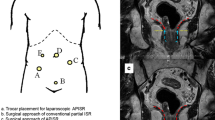Abstract
PURPOSE: Laparoscopic-assisted, sphincter-saving resection (largest incision <7 cm) of the middle and distal rectum is technically very difficult and, with regard to cancers, has not been demonstrated to be oncologically safe. The hypothesis of this retrospective study is that a hybrid operation that combines laparoscopic and open methods would be associated with short-term outcome benefits compared with open surgery results for patients undergoing sphincter-saving proctectomy. METHODS: A total of 31 hybrid and 25 fully open rectal resection patients were compared in this retrospective review. All patients had splenic flexure takedown and rectal anastomosis. The hybrid approach consisted of laparoscopic splenic flexure takedown (with or without partial rectal mobilization and devascularization) followed by completion of the procedurevia infraumbilical midline laparotomy. The indication was neoplasm in 87 percent of hybrid patients and in 68 percent of open patients. The majority of tumors were located between 4 and 10 cm from the dentate line. RESULTS: Fifty-eight percent of hybrid and 68 percent of open patients had low anterior or coloanal resections, and 48 percent of hybrid and 64 percent of open patients underwent temporary diversionvia ileostomy. The mean hybrid midline incision length was 11 cm compared with 24 cm for open patients (P <0.0001). The neoplastic specimens were similar with regard to margins and lymph node harvest. Similar complication rates were noted in both groups. Nonsignificant benefits for hybrid patients (0.9–1.2 days) were seen with regard to length of time until toleration of liquid or solid diet and first flatus. Hybrid patients experienced their first bowel movements 4.1 daysvs. 5.7 days for the open group (P=0.03). Mean length of stay was significantly shorter for hybrid patients (6.1. days) than for open patients (11.1 days;P=0.0006). CONCLUSION: This preliminary retrospective study suggests that a combined hybrid laparoscopic and open approach to sphincter-saving proctectomy permits a similar resection as open methods and may be associated with a length-of-stay benefit and more rapid return of bowel function. Prospective studies will be needed before any firm conclusions can be drawn.
Similar content being viewed by others
References
Wu JS, Birnbaum EH, Fleshman JW. Early experience with laparoscopic abdominoperineal resection. Surg Endosc 1997;11:449–55.
Seow-Choen F, Eu KW, Ho Yh, Leong AF. A preliminary comparison of a consecutive series of open versus laparoscopic abdomino-perineal resection for rectal adenocarcinoma. Int J Colorectal Dis 1997;12:88–90.
Ramos JR, Petrosemolo RH, Valory EA, Polania FC, Pecanha R. Abdominoperineal resection: laparoscopic versus conventional. Surg Laparosc Endosc Percutan Tech 1997;7:148–52.
Darzi A, Lewis C, Menzies-Gow N,et al. Laparoscopic abdominoperineal excision of the rectum. Surg Endosc 1995;9:414–7.
Bohm B, Schwenk W. Results of prospective randomized trials of laparoscopic versus conventional resection for colorectal cancer [abstract]. Int J Colorectal Dis 1998;13:179.
Schwenk W, Bohm B, Muller JM. Postoperative pain and fatigue after laparoscopic or conventional colorectal resections. A prospective randomized trial. Surg Endosc. 1998;12:1131–6.
Milsom JW, Bartholomäus B, Hammerhofer KA, Fazio V, Steiger E, Elson P. A prospective randomized trial comparing laparoscopic versus conventional techniques in colorectal cancer surgery: a preliminary report. J Am Coll Surg 1998;187:46–57.
Schwenk W, Bohm B, Witt C,et al. Pulmonary function following laparoscopic or conventional colorectal resection: a randomized controlled evaluation. Arch Surg 1999;134:6–13.
Kloosterman T, von Blomberg ME, Borgstein P, Cuesta MA, Scheper RJ, Meijer S. Unimpaired immune functions after laparoscopic cholecystectomy. Surgery 1994;115:424–8.
Whelan RL, Franklin M, Donahue J,et al. Postoperative cell mediated immune response is better preserved after laparoscopic versus open colectomy in humans: a preliminary study [abstract]. Surg Endosc 1998;12:586.
Allendorf JD, Bessler M, Whelan RL,et al. Better preservation of immune function after laparoscopic-assistedvs. open bowel resection in a murine model. Dis Colon Rectum 1996;39(Suppl):S67–72.
Decker D, Schondorf M, Bidlingmaier F, Hirner A, von Ruecker AA. Surgical stress induces a shift in the type-1/type-2 T-helper cell balance, suggesting down regulation of cell mediated and up-regulation of antibody-mediated immunity commensurate to the trauma. Surgery 1996;119:316–25.
Redmond HP, Watson WG, Houghton T, Condron C, Watson RGK, Boucher-Hayes D. Immune function in patients undergoing openvs. laparoscopic cholecystectomy. Arch Surg 1994;129:1240–46.
DaCosta ML, Redmond P, Bouchier-Hayes DJ. The effect of laparotomy and laparoscopy on the establishment of spontaneous tumor metastases. Surgery 1998;124:516–25.
Allendorf JD, Bessler M, Kayton ML,et al. Increased tumor establishment and growth after laparotomyvs. laparoscopy in a murine model. Arch Surg 1995;130:649–53.
Lee SW, Gleason NR, Ssenymanturo K, Woodring JV, Bessler M, Whelan RL. Colon cancer tumor proliferative index is higher and tumor cell death rate is lower in mice undergoing laparotomyvs. insufflation [abstract]. Surg Endosc 1998;12:514.
Kodama M, Kodama T, Nishi Y,et al. Does surgical stress cause tumor metastases? Anticancer Res 1992;12:1603–16.
The Clinical Outcomes of Surgical Therapy (COST) Study Group, Fleshman JW, Nelson H,et al. Early results of laparoscopic surgery for colorectal cancer: retrospective analysis of 372 patients treated by Clinical Outcomes of Surgical Therapy (COST) Study Group. Dis Colon Rectum 1996;39(Suppl):S53–8.
Trebuchet G, Le Calve JL, Launois B. Resection coelioscopique du colon pour adenocarcinome presentation d'une seriede 218 cas. Chirurgie 1998;123:343–50.
Leung KL, Yiu RY, Lai PB, Lee JF, Thung KH, Lau WY. Laparoscopic-assisted resection of colorectal carcinoma: five-year audit. Dis Colon Rectum 1999;42:327–33.
Poulin EC, Mamazza J, Schlachta CM, Gregoire R, Roy N. Laparoscopic resection does not adversely affect early survival curves in patients undergoing surgery for colorectal adenocarcinoma. Ann Surg 1999;229:487–92.
Franklin ME, Rosenthal D, Abrego-Medina D,et al. Prospective comparison of openvs. laparoscopic colon surgery for carcinoma: five year results. Dis Colon Rectum 1996;39(Suppl):S35–46.
Author information
Authors and Affiliations
About this article
Cite this article
Vithiananthan, S., Cooper, Z., Betten, K. et al. Hybrid laparoscopic flexure takedown and open procedure for rectal resection is associated with significantly shorter length of stay than equivalent open resection. Dis Colon Rectum 44, 927–935 (2001). https://doi.org/10.1007/BF02235478
Issue Date:
DOI: https://doi.org/10.1007/BF02235478




